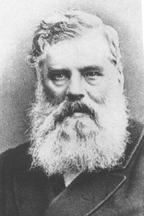Oldham, Thomas

Oldham, Thomas (1816-1878) Geologist, cartographer, administrator. Thomas Oldham was the first superintendent of the geological survey of india.
He was born in Dublin, Ireland in 1816. He studied civil engineering and geology at the Trinity College and Edinburgh University of Scotland. While at Edinburgh, he used to attend classes on Natural History taken by the (teacher of Charles Darwin) renowned Professor Robert Jamison for acquiring knowledge on Geology and Natural Sciences. He joined as head assistant of the chief of Ordnance Survey of Ireland Joseph Ellison in 1838. After inventing heat radiating fan in 1840, Oldham took it to the English fossil-expert Edward Forbes. Out of euphoria, Forbes named the invented object as Oldhama.
Sir Thomas Oldham joined as the first superintendent of the Geological Survey of India in 1851. He chalked out a plan to expand the area of work of the department in 1852. A group of scientists led by him made notable discoveries about the geological resources of India. During his 25 years tenure as the head of Indian Geological Department, Oldham could put the organisation on a firm footing. His notable works included establishment of the organisational headquarters in kolkata, and setting up of a museum as well as a library. As a colonial administrator and a professional scientist, Oldham successfully completed the assessment of coal resources in India. The publication of memoirs was started by the Indian Geological Survey Department in 1858-59 under the leadership of Oldham. One of the memoirs published in 1863 contained the first geographic map (1 inch = 1 mile) of the Raniganj coal mine. A scientist named Mallet completed a survey on the coal and petroleum resources of Assam during the tenure of Oldham. Oldham found that the Indians lacked knowledge of Geology due to an absence of proper training and institutional education. For improving this situation, he appointed three young geologists named Ram Singh, Kishen Singh and Heeralal in his office. He directed them to remain present during lectures on geological science at the Presidency College. This initiative by Oldham was successful to a large extent. Kishen Singh and Heeralal were serving as Deputy Assistant Geologists until his retirement from service.
Because of the contributions and farsightedness of these scientists, geological research and survey work in India could stand on a firm footing. Oldham himself was a great geologist of his time. Before joining the Indian Geological Survey Department, he was working as the curator of Dublin Geological Society. He was the first among the Irish geologists to have come to India. After him, 12 Irish geologists including his brother Charles, Professor William King of the geology department of Queen's College and Valentine Ball came to India. Because of the efforts of Oldham and his associates, notable improvements were made in the application of geology in India and researches continued work on the geological structure of different regions of the Indian subcontinent.
Oldham married Louisa Matilda Dixon of Liverpool in 1850. His first son Richard Dixon Oldham undertook research on the terrible earthquake that took place in Assam in 1897 and showed that three different kinds of pressures were created due to the earthquake. Based on these new information and explanations, Richard held the view that the core of the earth was composed of liquid substances.
Oldham resigned as the chief of Geological Survey Department of India in 1876 due to his failing health. After this, he settled in the Rugby town of England and died on 17 July 1878. [Ashfaque Hossain]
